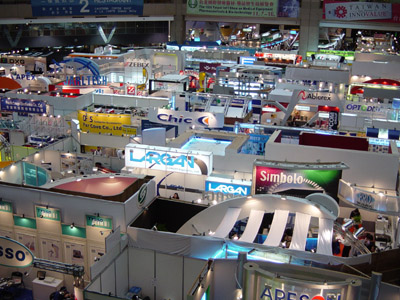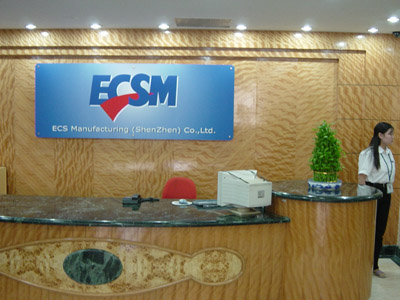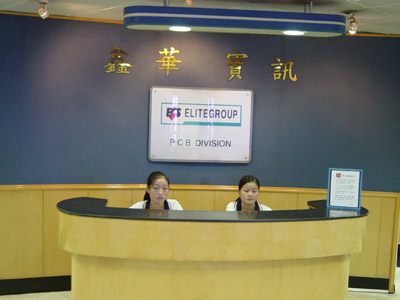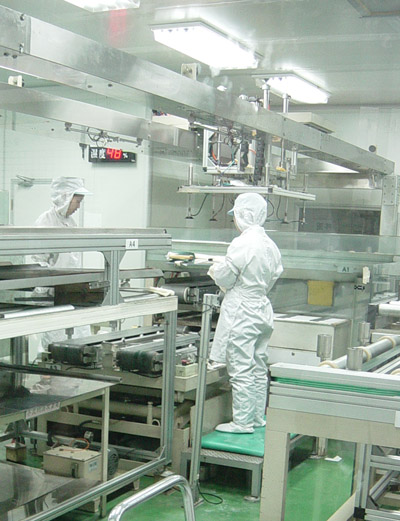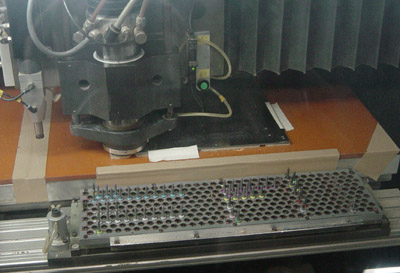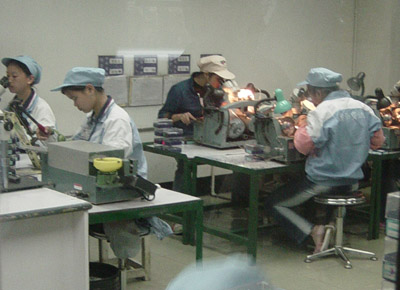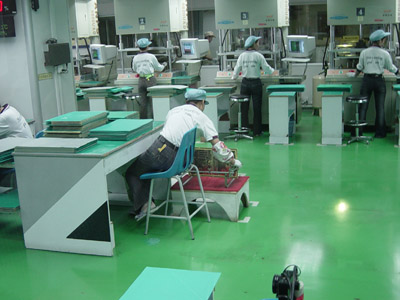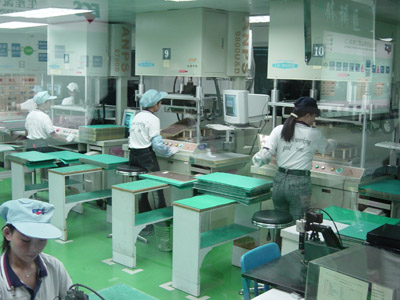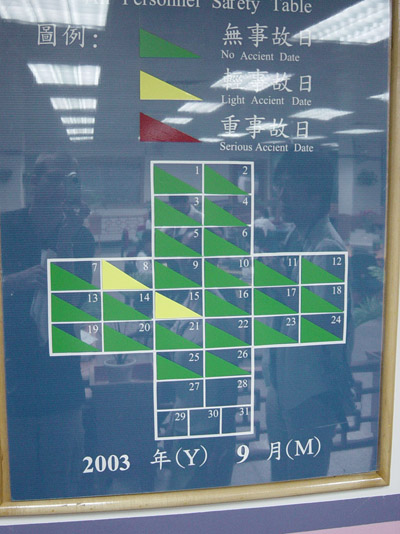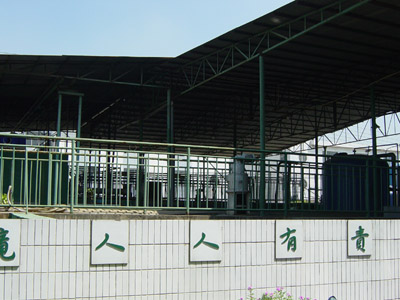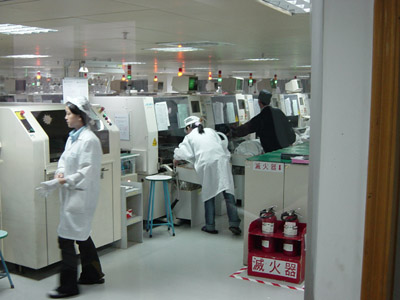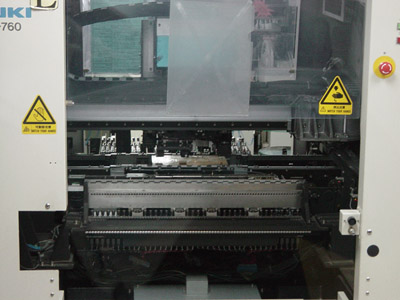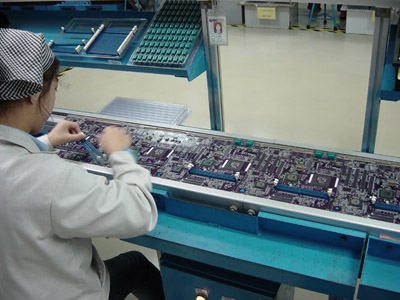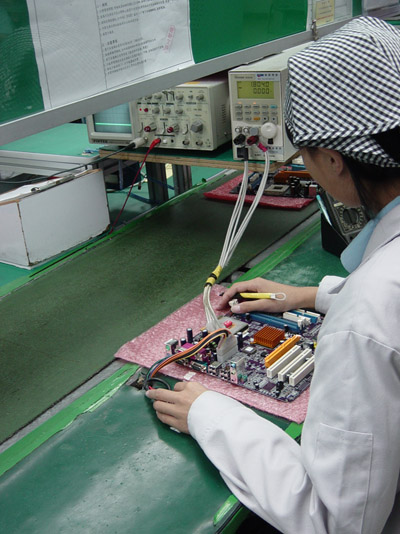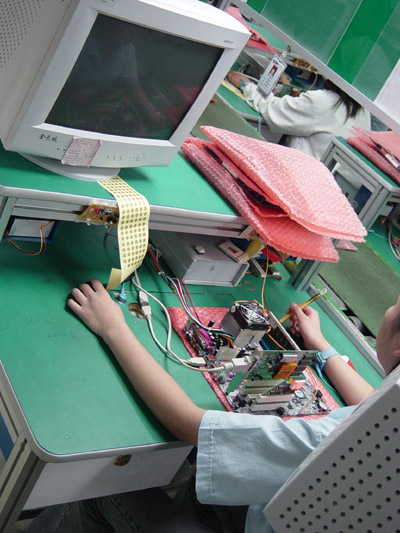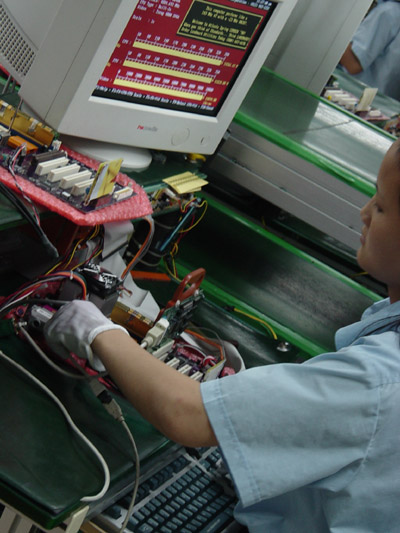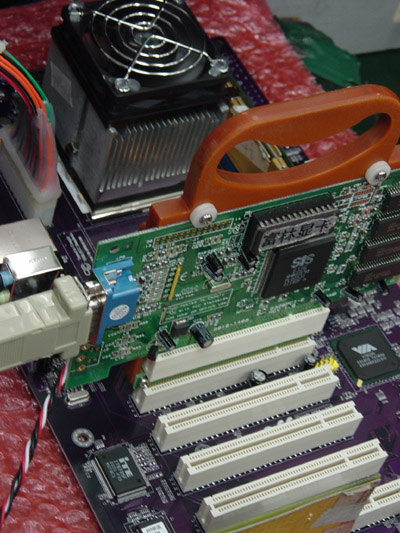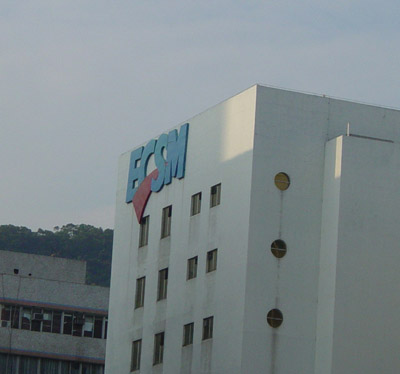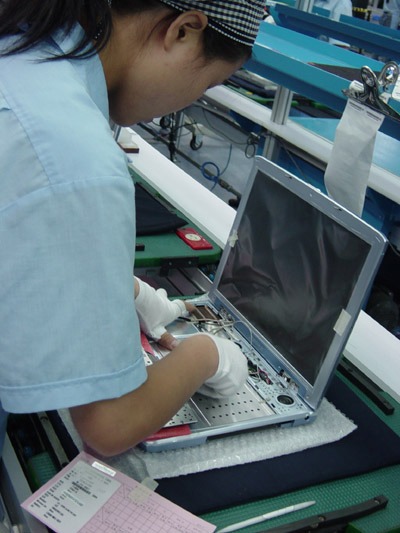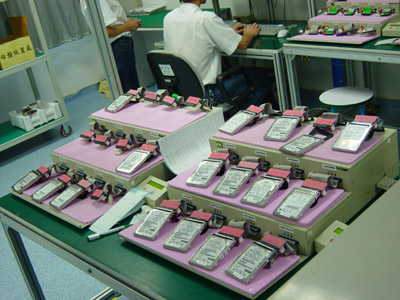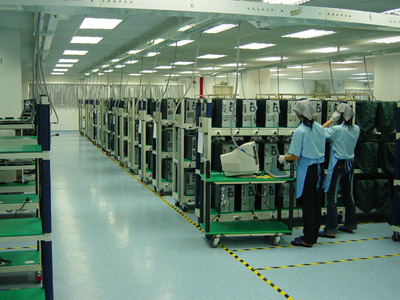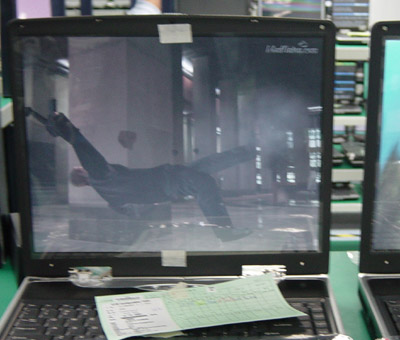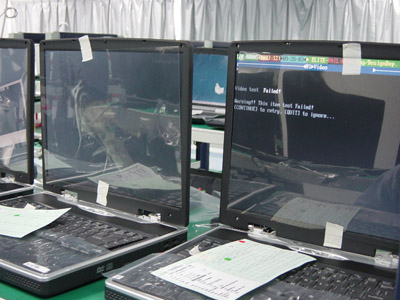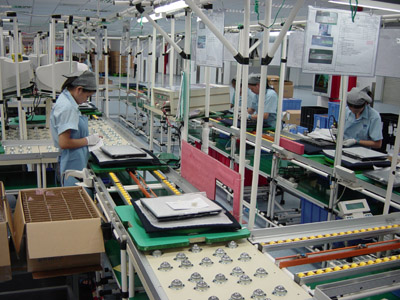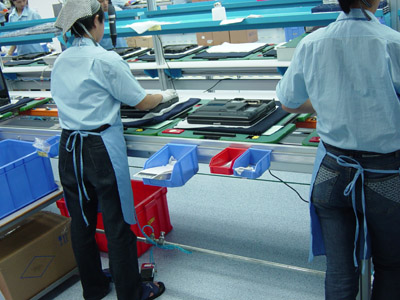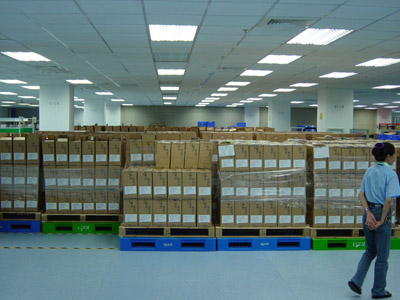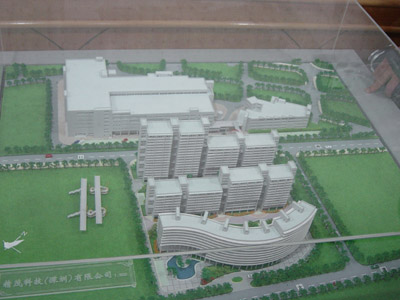
Original Link: https://www.anandtech.com/show/1171
Inside Elitegroup Computer Systems: From Taipei to Shen Zhen
by Kristopher Kubicki on October 4, 2003 12:39 PM EST- Posted in
- Motherboards
Getting down to the politics of the situation, the partnership between PC Chips and ECS is actually slightly complicated. For those of you who don’t quite know the situation between China and Taiwan, let us take a crash course in Chinese politics. China technically considers Taiwan as a “rogue state,” and thus, it does not allow Taiwanese citizens and companies the same rights as Chinese. The PC Chips CEO, Johnson Chiang, is a Taiwanese citizen and may not own Chinese factories, offices, etc. In the early 90’s, PC Chips became one of the first motherboard companies to spin off a motherboard production factory, which is actually its own company, in mainland China.
Edit: Joseph Yu, our tour guide for the ECS factory provided us with a few details we got wrong: Mr. Johnson Chiang became one of the major shareholders of ECS in 1998 while he was Chairman of PC CHIPS. But, this was Mr. Chiang's personal investment. In fact, Pou chen Group, the world's leading shoe maker who design & OEM for Nike, Rebook, and Adidas, is the biggest shareholder of ECS (13.56% in 2002). Precisely speaking, Mr. Chiang became Chairman of ECS in 1998, but did not take over ownership of ECS. Due to Mr. Chiang's relationship toward this two companies, ECS and PC CHIPS began their cooperation on manufacturing since then. From legal aspect, these two are still independent companies.
Getting to China
Computex 2003 Hall 1 Showfloor
As we mentioned earlier, the ECS-PC Chips company is headquartered in Taipei, Taiwan (Republic of China). There are dozens of ECS branches in the world, from California to Japan, South America and Europe. Because we were in Taipei for Computex 2003, we had a perfect opportunity to visit Shen Zhen, China and see the production facilities of ECS firsthand.
Already, just getting to the factory in China is a political fiasco. For US and European citizens, the ability to travel into China requires only a Visa, which is usually pretty easy to obtain. However, our Taiwanese hosts required a bit more paperwork since the Chinese government does not recognize Taiwanese citizens as Chinese citizens. Thus, only the port city and former British ruled colony of Hong Kong allows entry to planes from Taipei. Our final destination, Shen Zhen, has an international airport, but we have to fly from Taipei to Hong Kong and then drive 2 hours from Hong Kong to Shen Zhen. Six checkpoints and 5 hours after leaving the Taipei World Trade Center, we arrived at our destination: ECSM Shen Zhen.
The ECSM facility is comprised of three separate buildings. The #5 and #20 factories are owned by ECSM (one of the Chinese sub-companies in Elitegroup), while the #26 factory is a new factory that is owned by ECS Taiwan. Chinese government allowed ECS to become one of the first Taiwanese companies to own a factory in Shen Zhen, a fact they are quite proud of. It is easy to forget that Shen Zhen used to be a sleep port city neighbored to Hong Kong. As an experiment in the late 1970’s, China allowed Shen Zhen to become the first city in the country to allow capitalism. As the city exploded into a metropolis of more than 7 million people, the Chinese government watches the city and its workers vigorously.
Head Quarters: Factory #20
Our tour started slightly backwards, as we began in building #20, which is usually used for motherboard assembly. The temporary nerve center for all of the Chinese conglomerate companies exists on the 7th floor of this inconspicuous factory along the southern coast of Shen Zhen. At the time of the tour, ECS was moving the office facilities into the 10th floor of the new #26 E-Trend building (ECS Taiwan).We would actually be returning to this factory later in the tour, but for now, we can give a few specifics about the production campus. The whole facility employs about 7,000 people, of which at least half are dedicated for quality assurance only. In 2002, ECSM was the largest motherboard production facility in the world, with over 2,000,000 motherboards and 1,000,000 adaptor cards per month in production. ASUS now produces slightly more, around 2,100,000 motherboards per month. However, this milestone is constantly traded off between the two powerhouses.
Biloda PCB: The Birth of a Motherboard
To say a motherboard is “born” would be the actual PCB fabrication itself. As we mentioned earlier, Elitegroup owns its own production facility in Shen Zhen off the ECSM campus. Biloda, as it is called, is one of ECS’ prized facilities. The factory itself has 1,700 workers, and like most factories in Shen Zhen, the workers live on campus in their own dormitories. Remember, Shen Zhen is a work district; so workers come from other providences in China to work even for a mere $150USD per month. Although it would never be allowed in most countries, the workforce is primarily female because studies seem to prove that females have a slightly higher concentration level than males. Accept it or not, ECS is only one of thousands of companies that employ females for manual labor.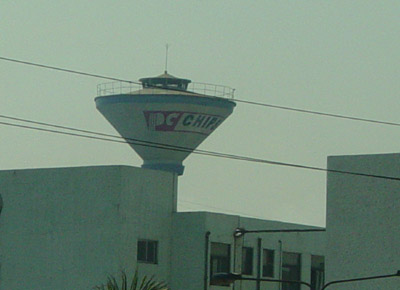
However, that is enough about politics for now. As we pulled up to the Biloda PCB factory, it’s very apparent that this factory complex is completely different from the ECSM campus. This is one of the older facilities in the company, built in 1995. The factory chairman is the same Johnson Chiang, President and CEO of PC Chips. Thus, while touring the factory, pretty much everything seemed to have PC Chips still written on it. It is sort of a moot point since this factory is actually slated to be replaced with a newer facility capable of 300,000M2/month of motherboard PCB.
Click to enlarge.
Above, you can see two workers pressing PCB layers together. This is where the motherboard begins its long journey to becoming a final product. In this particular image, 4 layers of PCB are pressed together with insulation between each material. Obviously the more layers, the higher the signal quality of the circuitry of the motherboard. ECS has other facilities in the Biloda complex capable of 6, 8 and even some 10 layer production. You may know that PC Chips recently got into the ATI video card business, and 4 layers PCB just doesn’t cut it. Also for laptops, ECS needs to use 8 and 10 layer motherboards to keep interference down.
At this point, the board is etched for drilling. A black oxide process covers the etched elements, and then the board is finally laminated. Once it is laminated, the board looks just like a flat blank PCB.
Click to enlarge.
Next you’ll see that the pressed motherboard is moved over to the drilling factory. This is a separate building from the rest of the facility and clearly, the part of the tour where everyone goes “ooh — ahh”. Once a board has been pressed and cooled, the motherboard needs to be drilled anywhere between 5,000 to 10,000 holes in order for the circuitry to travel from the top to the bottom of the board. Furthermore, any components that need to be mounted on the motherboard itself, such as sockets or jumpers, also get drilled a hole. Right now, the motherboards are in “plates” that usually fit two separate motherboards. Thus, any process from here until the end of printing is actually working twice.
In the particular 4-layer drilling center we were in, about 40 machines drilled 6 to 12 plates at a time (12 to 24 motherboards). The process takes an hour to complete one cycle, thus generating about 500 motherboards an hour. Since Biloda works on two shifts, a daily yield in this 4-layer facility yields at least 5,000 motherboards a day, or 140,000 per month. In fact, the factory has its own technicians that just sharpen the drill bits all day, everyday!
Sharpening drill bits.
That seems like a lot for one little factory, but keep in mind that the boards have not gone through any QA yet. A majority of the boards are rejected, and also a large majority of the boards are used for different clients. ECS itself is responsible for three brands, including PC Chips, ECS and Matsonic. ECS targets PC Chips components at the entry level market, while ECS branded components are for the middle grade components. Matsonic is not terribly popular in the US, but all three brands account for enormous OEM market share (over 15% at time of publication). Furthermore, from time to time we got the occasional glimpse of Abit and Shuttle motherboards in various levels of PCB production. While one in seven motherboards might be from ECS, the chances that your motherboard came from Biloda are even higher!
Biloda PCB: OS Testing and Lithography
Click to enlarge.
Finally, the drilled boards are scrubbed. Up until now, this is the first time we've seen male workers in the factory. In case you are interested in knowing what is on the shirt of the man on the left, it says, "Have a working good time." I emailed Anand if we could get polo shirts with that motto on it, but I did not get a response.
The majority of the small drill holes are filled with the particular solder or copper through chemical lithography. The motherboard circuitry itself is "printed" right on the board using large machines that somewhat resemble Xerox copiers. A negative image of the circuitry is placed over the board, and then a chemical process removes the exposed top layer not covered by the negative. A resulting circuit is produced. Workers flip the board and repeat the process to create a double-sided circuit board.
Click to enlarge.
Now this thing is starting to look more like (two) motherboards! After the board is done printing, it immediately goes across the hall to the OS testing room. The QA on the motherboard line really picks up at this point. These large machines take the motherboards and press a matching circuit design on the top and bottom. A current is passed through and the monitor tells the worker whether or not all electrical paths are correct.
The next (immediate) room contained the print facilities. Although I can't exactly describe what this guy is doing, I believe the process is somewhat similar to silk screening. This particular red dye is being applied over some PC Chips motherboards. One thing that struck us as odd is that there has been a surprising amount of manual labor up to this point. Considering the extremely cheap cost of workforce, it certainly must be cheaper and more effective to use manual labor in a high volatile sector like the motherboard industry. ECS was very proud to let us know that tooling a motherboard into full production only takes seven days from receiving the CAD/CAM layout from ECS Taipei. Certainly an impressive fact, although it's quite obvious that the only changes that are really needed (besides loading the software in the drilling machines) are with the manual laborers.
In any case, the factory itself does seem safe extremely considering all of the manual labor around. No doubt the monthly safety record is written in English as well as Chinese so that nosy American reporters will take a picture of it.
Click to enlarge.
Finally, as we left Biloda, we got one scenic shot of the onsite water treatment facility. All of those plastics, oxides and dyes need to be treated before they are dumped back into the ocean. Regardless of the fact that no one else within a 30 mile radius seemed to care at all about any sort of pollution control, Biloda does a very good job of providing adequate environment awareness. In fact, our tour guide went into a 20 - 30 minute analysis of it; but, we really want to see what's going to happen to these motherboards, so let's skip that part for now.
Dragontop and ECSM
Unfortunately, we did not get a chance to visit ECS’ Dragontop facilities. Another one of the ways ECS keeps its costs so low is by manufacturing most of its own connectors for the motherboard. Dragontop is a joint venture with AMP, perhaps one of the largest component manufacturers for PC motherboards. Once again, our PC Chips friend, Johnson Chiang, saw an opportunity and jumped all over it when a Hong Kong company put the factory up for sale in the mid nineties. Since we didn’t get a chance to see it, there isn’t really much to talk about. However, if you get a new motherboard and see AMP or ECS written on any of the components, you’ll know it is thanks to another one of Johnson’s factory.Click to enlarge.
We are back in factory #20, and its time to cut those motherboard plates in half. While the whole facility has over 60 SMT lines, the floor we were on only contains 12. These are massive machines capable of soldering hundreds of machines an hour. The 60 lines we mentioned are capable of soldering 120,000+ boards per month.
Click to enlarge.
The next part is fairly fun to watch as well. Most motherboards are constructed in line assembly setups. About 25 workers will sit in a line and plug a few components into the predrilled board. Remember, the SMT machines have already connected north bridges, LAN and other chips. The few connectors and sockets left just slide into the board like some kind of unusual LEGO set. A final worker verifies that the components are all set in place, and then the assembly line puts the board in an oven.
Click to enlarge.
At this point, the boards continue down an elevator to one more floor where they will be tested for quality. Much to my surprise, the Quality Assurance (QA, but ECS also calls it Manual Inspection) portion of the factory seemed to consume the most time and energy. Below, you can see a worker testing the motherboard CPU socket for correct voltages. This is one of five or so specific component tests.
Click to enlarge.
Here, a worker actually assembles a full system and starts it up to run. Each component of the motherboard is tested from LAN to CPU. It only took about 5 minutes for this worker to assemble the unit, run about 10 DOS-based tests on it, and then disassemble it. If you ever felt like winning one of those CNET system builder contests, you could get one of these ECS girls to be a pretty sure ringer.
Below, a worker tests the network components of a motherboard.
A specially designed video card that can be removed and inserted into a motherboard without damaging the pins on the motherboard or the card.
E-Trend: Factory #26
From the #26 factory roof, we can practically throw a stone at the #20 building we were just in. The part you can’t see is the steel and stone wall around the building we were in. We mentioned earlier that factory #26, E-Trend, was an experimental facility where the Chinese government allowed ECS Taiwan to own a factory on Chinese soil. Obviously, things like security checkpoints and 7-foot high walls are some of the terms that go along with that deal!Similar to the motherboard assembly line, we got to see a laptop assembled in less than 5 minutes as it cruised down one of the assembly lines. As you will see, the entire laptop is assembled and tested, even if only the components or barebones laptop is the desired product. ECS reported in their last quarter that 47% of their profits came from laptop sales, rather than motherboard. While at the factory, we saw more than 7 completely different types of laptops; so it is clear that ECS is an even bigger OEM of laptops than they let on to be.
Here, a worker attaches circuitry for the LCD panel.
When you build 30 or 40 laptops an hour, per assembly line, using a blaster system to copy the contents of one hard drive onto 15 others saves a lot of time. The E-trend facility had about 20 of these stations on the assembly floor.
We will return to this part of the factory in a bit. Right now, we will head over to the QA floor. As it is easy to see, this is no small operation. Each of these systems (shown below) will run for 4 hours of high load before being boxed up. The particular OEM client ordered a few thousand components. ECS is capable of testing 40 racks of these machines, each with 15 units on each rack. Since this factory also works on two shifts, that’s about 1200 systems per day from this floor.
Click to enlarge.
E-Trend uses an identical setup for laptops, with 15 units per rack. 400 laptops running 3DMark2001 at the same time has an unusual, but calming, sound to it.
We found a bad laptop in the fray. ECS wouldn’t let me take it home.
Click to enlarge.
E-Trend: More QA
The previous factory wing we were in used line assembly for the motherboards and high volume laptops. Since those are high volume productions (1 million boards or more!), tooling a line over for the final motherboard makes sense. However, in this part of the factory, a cell approach is better suited.About six workers each accomplish several tasks per station rather than 20 workers accomplishing 1 task. The result is a lower output, but easier turnarounds for smaller orders. Keep in mind, when ECS says small, that could be anywhere between 5,000 to 25,000 units.
In the background, you can see these systems running a burn-in test. While the previous systems we saw ran for 4 hours, this client required their new systems to burn in for 8 hours.
Here, you will see ECS employees dismantle some OEM laptops to remove the processor and hard drive. The OEM client will then put their own CPU and hard drive into the laptop.
Below we have a snapshot of a real lot of OEM systems. There are 36 systems per pallet and about 15 pallets; and this isn’t even the warehouse.
Final Thoughts
All three campuses in the Shen Zhen district are currently developing new factories and dormitories. The Dragontop component factory is moving to a new 80,000 sq ft facility, and the Biloda PCB factory is getting ready to strike ground on their 80,000 sq ft factory campus. This will bring the Biloda factory campus up to 6 production buildings plus another 6 dormitories and administration buildings (thus, increasing their production to 300,000 m2 per month).Furthermore, the ECSM campus is also undergoing renovation and changes, building another 3 dormitories and one factory. Even as we visited the factory, we got to see a glimpse of the new offices moving around into new buildings.
Perhaps our tour de ECS provided an insightful look into the world of motherboard manufacturing. Stay tuned as we have more factory tours and motherboard reviews coming your way!

